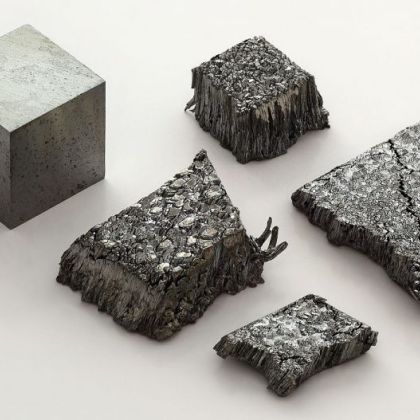LU • Atomic Number 71

Lutetium
Lutetium is a silvery, lustrous metal and the last and heaviest element in the lanthanide series. It belongs to the group of heavy rare earth elements.
It is the rarest and most difficult-to-extract element among the rare earths. Pure lutetium oxide or metallic lutetium is one of the most valuable rare-earth materials.
One of the most notable properties of lutetium is its exceptionally high hardness and density for a rare-earth metal.
Its main application is in nuclear medicine.
Lutetium was discovered independently in 1905 by three scientists — Carl Auer von Welsbach, Charles James, and Georges Urbain — the latter naming it after Lutetia, the ancient Roman name for Paris.
In German-speaking countries, it was commonly known as Cassiopeium (chemical symbol Cp) until 1949.
Xenotime is the most important mineral source of lutetium. It preferentially concentrates the heavy rare earth elements (including yttrium). In xenotime, lutetium is often present in higher concentrations than in other minerals.
The main producing country is China.
After an elaborate separation of the other accompanying rare-earth elements, the oxide is converted into lutetium fluoride using hydrofluoric acid. This fluoride is then reduced with calcium, forming calcium fluoride and metallic lutetium.
Remaining calcium residues and impurities are removed by an additional vacuum remelting process.
The most important and significant use of lutetium is in modern medicine, particularly in cancer therapy.
Lutetium-177 (¹⁷⁷Lu) is a radioactive isotope used as a theranostic agent — a term that combines therapy and diagnostics, describing a revolutionary approach in oncology.
For diagnostic purposes, lutetium emits a small amount of gamma radiation, making tumors visible to physicians via a SPECT camera (Single-Photon Emission Computed Tomography).
For therapy, ¹⁷⁷Lu emits beta radiation (β⁻ particles). These particles have precisely the right energy to selectively destroy cancer cells while leaving the surrounding healthy tissue largely unharmed.
Special applications of lutetium include its use in scintillators (detectors) for cancer diagnostics. Lutetium orthosilicate (LSO) and lutetium yttrium orthosilicate (LYSO) are extremely efficient crystals used in medical PET scanners (Positron Emission Tomography).
In addition, lutetium compounds serve as highly active catalysts in the petrochemical industry, for example in polymerization and petroleum cracking processes.
| General Information | |
| Name, Symbol, Atomic Number | Lutetium, Lu, 71 |
| Series | Lanthanide |
| Groupe, Periode, Block | La, 6, f |
| Appearance | Silvery white |
| CAS-Number | 7439-94-3 |
| Abundance in Earth's crust | 0.7 ppm |
| Atomic Properties | |
| Atomic Mass | 174.967 u |
| Atomic Radius | 175 pm |
| Covalent Radius | 187 pm |
| Electron Configuration | [Xe] 4f¹⁴ 5d¹ 6s² |
| 1. Ionization Energy | 523.5 kJ/mol |
| 2. Ionization Energy | 1340 kJ/mol |
| 3. Ionization Energy | 2022.3 kJ/mol |
| 4. Ionization Energy | - |
| Physical Properties | |
| State at 20 °C | Solid |
| Crystal Structure | Hexagonal |
| Density | 9.84 g/cm³ (25 °C) |
| Magnetism |
Paramagnetic (χm = 0.0) |
| Melting Point | 1925 K (1652 °C) |
| Boiling Point | 3675 K (3402 °C) |
| Molar Volume | 17.78 × 10⁻⁶ m³/mol |
| Heat of Vaporization | 415 kJ/mol |
| Heat of Fusion | 22.0 kJ/mol |
| Electrical Conductivity | 1.72 * 10⁶ A/(V·m) |
| Thermal Conductivity | 16 W/(m*K) |
The silvery-gray metal is very soft, highly ductile, and malleable. In dry air, lutetium is relatively stable, but in moist air, it tarnishes to a gray color. At elevated temperatures, it burns to form the sesquioxide Lu₂O₃. It reacts very slowly with water, producing hydrogen gas and forming the hydroxide. Lutetium dissolves in mineral acids with the evolution of hydrogen.
In its compounds, lutetium occurs exclusively in the oxidation state +3. The Lu³⁺ cations form colorless solutions in water.

Rare Earth Elements

